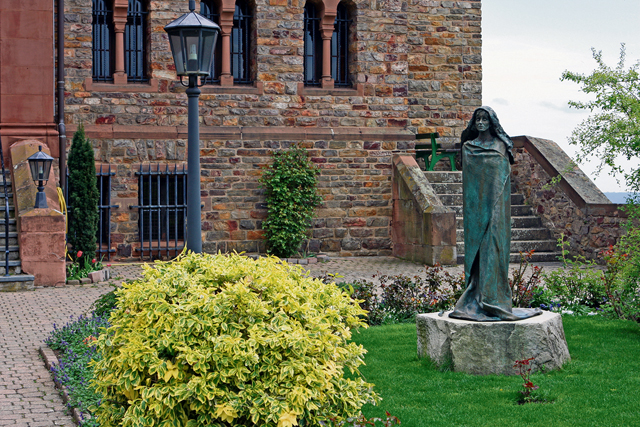
As saints go, it is not often that a woman is honored. In this article we will talk about Hildegard of Bingen. Bingen is a picturesque town not far from the Kaiserslautern Military Community.
Hildegard of Bingen was born as the last of ten children, about 1098 from the family of Bermersheim, a lower nobility family. She was a weak and sickly child, and, in her autobiography, she stated that she experienced “visions” from early childhood onward.
On the other hand, she grew to become a very emancipated woman of the time and is considered to be the founder of scientific natural history in Germany.
It might have been because of her visions that her parents offered her as an oblate to the Benedictine monastery at Disibodenberg, which is located in the Palatinate Forest today. Though it is unknown of her exact age at the time, either 8 or 13, she took her vows on Nov. 1, 1112, by Bishop Otto of Bamberg.
During her time in the monastery, she was inspired by the herb garden and quickly acquired broad knowledge about herbs and their medicinal effects. She soon became a writer, composer and philosopher, an unusual skill at the time, as only few women were educated and able to read or write.
At an early age she became well-known as a mystic, visionary and medicinal writer and practitioner, and honored by the pope himself.
By 1136 her convent elected her as mother superior and in 1150 she founded her own monastery in Rupertsberg near Bingen, to be followed by the second convent Eibingen in 1165. There she wrote theological, botanical, medicinal works as well as letters, hymns and antiphons for the liturgy. There are more surviving chants by Hildegard than by any other composer from the Middle Ages and she is one of the few to have written both the music and the words.
Although she always highly respected and was true to her vows, Hildegard came to be known as being rather liberal and she enjoyed traveling throughout the country. Though this information cannot be confirmed, it is said that she also visited Kaiserslautern on various occasions.
Given the overall status of women during the early Middle Ages, this remarkable woman was highly respected by prestigious personalities in politics and the church. She engaged in frequent correspondence with kings, popes, the archbishops of Trier, Salzburg and Mainz. One of her favorite “pen pals” was none other than Emperor Friedrich Barbarossa. Furthermore, other abbesses and the simple folk turned to her for advice on medicinal questions or spiritual matters.
Regional calendars of the Roman Catholic church have listed her as a saint for centuries, and May 10, 2012, Pope Benedict extended the veneration of Saint Hildegard to the entire Catholic church and named her Doctor of the Church in October of the same year in recognition of her sacred life and teachings.
St. Hildegard died September 1179, at the surprisingly old age of eighty-one, given her poor health as a child. She also appears in the calendar of saints in various Anglican churches, such as the Church of England, and is commemorated Sep. 17 each year.
Whether her long life is attributed to her expert knowledge of herbs or her strong belief, she is renowned worldwide for her humanistic works and open-minded attitude.


